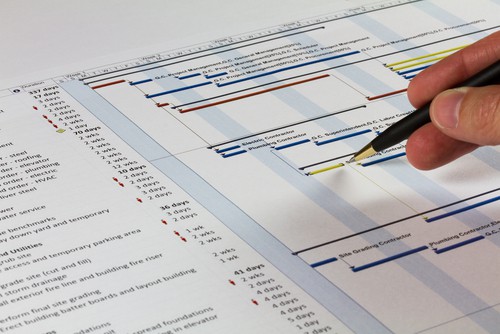Organizing and Scheduling a Construction Project
Organizing and Scheduling a Construction Project
With RFPs, contracts, invoices, blueprints, and more, it can be hard to keep track of all the necessary documents in a construction project. Because construction projects are so large and involve complex information, organization is key to staying on schedule.

Organization Strategies
Records Management: Record management controls the distribution, storage, and retrieval of project records, both hard copies and electronic, in a safe, secure way. Project managers must make sure that all incoming and outgoing documents are transmitted through the records management specialist, who uses software to track the records (this method will also create a central library of all project documents and information in one place).
Contract Management: It is important to clearly define the roles and responsibilities for the project team members who are managing the project and the project staff responsible for managing contracts and documents. The contract management plan is designed to set expectations and procedures around this by addressing who has the authority to direct and approve the contractors to work, how the contractor’s work is monitored and reported, how they are paid and approved, how contracts are modified, which financial audits are necessary, etc.
Contract Procurement Planning: Project managers also have to ensure that procurement activities fit with the project plan. Some of the tasks they have to manage include:
- Setting expected contract price
- Creating the scope of work (SOW) for each contract
- Standardizing procurement documents and any other necessary documents
- Adding completion dates to contracts that align with the project schedule
Commissioning Plan and List: The commissioning plan and list should be started early in the design phase and continually updated as the project progresses. The commissioning plan is designed to provide direction for the commissioning process during construction, to resolve issues related to scheduling, roles, and responsibilities, and to aid in the reporting, approvals, and coordination. It is a systematic process to ensure that buildings perform according to the design and to the owner’s operational requirements.
Project Control Process: The project control process tracks and manages the scope, cost, and schedule of a construction project. The goals of this process are to establish a baseline, track performance against the baseline, forecast performance at completion and compare to the baseline, and identify changes and monitor the effects to the baseline.
Project Requirement Definition: Also known as the statement of work, this document details the project deliverables. In the project requirement definition (PRD), the project manager explains the scope of work and what the project will accomplish. It helps stakeholders, team members, and external parties all understand the goal of the project and acts as a record of initial expectations.
As-Built Drawings: Also known as record drawings, these are edited drawings submitted by a contractor at the end of a project. They reflect all the changes made in the working drawings during the construction process, and show the dimensions, geometry, and location of all elements included in the contract. As-built drawings provide a quick visual into the existing design and capture deviations from the original documents.
Daily Documentation: Keeping diaries, logs, and daily reports of project activities acts as a reference guide after the work is completed and can mitigate any damages. This kind of documentation can show how questions were answered, how problems were solved, and tracks any unusual conditions on a certain day. By keeping these daily logs, you are leaving a paper trail throughout the whole project in case anything goes awry later on.
Scheduling Strategies
Organizing your documents helps you categorize and prioritize important project information, and once you have everything stored in a central location, you can build out your project schedule.
A well-defined schedule provides a structured approach to planning, identifies problems before they arise, forecasts cash flows, and assesses resource requirements.
Here are the fundamental and advanced scheduling techniques:
Fundamental and Advanced Scheduling Techniques
Gantt charts: A Gantt chart is the easiest way to create a construction schedule. It lets you visualize your project timeline by transforming task names, dates, durations, and end dates into cascading horizontal bar charts. Learn more about creating and using Gantt charts in Smartsheet.
Critical path scheduling: The most widely used scheduling technique is the critical path method. This method calculates the minimum project completion time and the start and end dates for all project tasks. It identifies the critical tasks that, if delayed, will delay your entire project. The critical path method helps you reduce timelines, manage resources, and compare planned with actual. To learn more, read our Ultimate Guide to the Critical Path Method.
Line of Balance: This scheduling technique is best suited for repetitive work and is often employed in road construction. It is a management control process for collecting, measuring, and presenting facts relating to time, all measured against a specific plan. With a Line of Balance schedule, you must allocate resources for each step, so you can make sure the next step is not delayed.
Q Scheduling: This form of construction scheduling addresses the sequence of activities, relationships between tasks, and the total cost of finishing the project. It includes the overall construction site and prevents two competing activities from happening at the same time at the same location. While this technique is the closest to reality, it requires special software and can take more effort from the project manager to evaluate cost analyses for the different schedule alternatives generated.
Comments